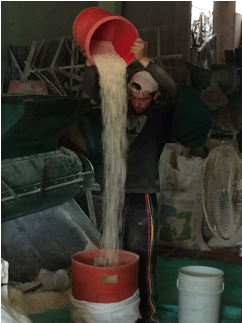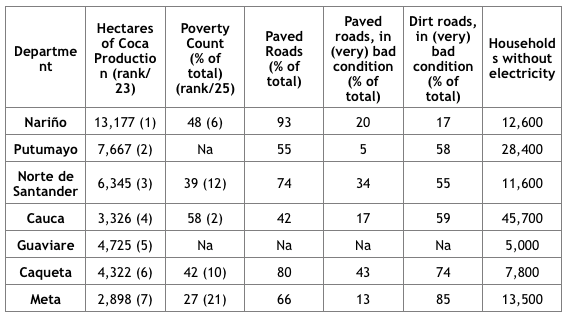By Alastair Smith, GDPO Research Associate.
In mid-May 2015, Ross, Dave and I left the relatively comfortable climate of Bogotá and headed to the humidity of South East Colombia and the Department of Guaviare to conduct fieldwork. Leaving the Department’s capital, San José del Guaviare, Pedro Arenas – the city’s previous mayor, current director of the Observatory of Declared Illicit Crops and Cultivators at the NGO INDEPAZ, and our guide for the weekend – explained that although Guaviare has been settled since time of Spanish conquistadors, the rural population greatly increased during and after the period of Colombian history known as ‘The Violence’. This was a ten year period (1948-58) of civil war in Colombia when the Colombian Conservative Party and the Colombian Liberal Party fought for dominance, and during which it is estimated that some 200,000 lives were lost. In an effort to flee the problems that came to San José, much of its population moved further into the countryside both temporarily and permanently. Pedro further explained that after the upheaval, the government offered land titles and investment to those moving to the rural area. However, as the government failed to honour these promises, an increasing population was left with little other than subsistence farming for their survival (Ortiz, 1984). As a capitalist economy grew around them, campesinos became aware of the opportunities to sell the traditional crop of coca for conversion into cocaine. For the first time, the communities were faced with the opportunity to stabilise their subsistence existence and offer a decent future to their families – although they lived nothing like the extravagant lifestyles synonymous with processors and traffickers working higher in the supply chain.
Moving through the countryside, the panoramic pasture with its sparse population of cattle – apparently underused for productivity, as powerful interests accumulate land primarily as an investment and a status symbol – began to merge into patches, and then significant areas of uncleared jungle. As we sat in the rear of our 4×4, cushioning ourselves against the contours of the dirt track road (only reasonably passable with such a vehicle or motorbike, and the expert manipulation of Freddy our driver), our travel companion, a local community leader, explained the basic truths of coca production. His language was human, straightforward and non-technical; yet he eloquently outlined a situation which formal national and international drugs policy in Latin America and Colombia, has always, and continues to largely disregard.
The community has been born into a context where the possibilities of development constantly fail to emerge due to a lack of even the most basic of investment. While there are major roads that connect San José to Bogotá and other large regional centres, the majority of communities remain connected only by dirt tracks, which are in a volatile state due to the local climate. Our own travel time consumed four hours in both directions, despite moving only 60km into the interior. As explained by other community leaders, the lack of reliable and passable roads drastically impede the sale of legal agricultural produce to local urban markets: long travel times undermine the ability to provide a reliable supply and drastically increase the transport costs associated with the purchase of inputs and sale of the final products.
In the country as a whole, 75% of roads are paved and generally in good condition (Ministerio de Transporte, 2014). However, those in the countryside are the least developed and least well maintained. A quick comparison, undertaken back at our hotel, identified something of a correlation between the UN 2013 estimates of coca growing and government statistics on the existence and quality of roads. To take one example, in Putumayo, the second biggest producer of coca, only 54% of roads are paved, and over 57% of the remaining dirt track routes are currently evaluated to be in “bad” or “very bad” condition (Ministerio de Transporte, 2014)
In the morning we were lucky enough to have met with the Governor of the Department of Guaviare, José Octaviano Rivera Moncada. Moving from a campesino family into politics, inspired he said by the lack of representation that he witnessed as he travelled the region as a rural health worker, the Governor explained that his department was critically underfunded, pointing out that while his administration had been able to make investments, it was almost entirely the result of locally raised funds. The central Government does not provide sufficient support for development in his view. One reason for this, as suggested by a number of people we met during our time in Guaviare, is that there is little incentive for politicians and government officials to provide for the isolated communities. By way of explanation, people point out that the political support in the region is of little consequence, and there is better status (and some say money) to be generated (through corruption and kickbacks) by focusing efforts elsewhere.
By generous invitation we accompanied the Governor to a village where we had the opportunity to participate in a momentous event in the community’s history. In the year 2015, this village was to be connected to the electricity grid: meaning that until that day, the households there had been among the 6,300 in the department, and 435,500 nationwide, officially estimated to be living without an electricity supply of any kind (MMEUPME, 2014). Again, reviewing numbers of households without electricity in the departments where coca is grown reveals a potentially telling pattern. Indeed, talking at the event, we met with further leaders from surrounding villages also still without this basis economic input. Talking of their current economic situation, they posed the rhetorical question: ‘How are we to generate income for our communities without electricity?’ ‘How are we expected to store food crops in a way which keeps them suitable for market?’ The answer they immediately follow with is the logically obvious one: ‘We simply can’t’. It is perhaps partly for this reason that coca tends to be grown in areas with notable levels of poverty (see Table 1, below – although, it should be noted that statistical analysis correlates coca with mid-levels of poverty, likely because of the need for some capacity to engage in the activity). Overall, we encountered the same position in all the communities we visited: the people are desperate for alternative livelihood options, but without roads and electricity, from which one leader noted many other opportunities would come, the only rational option for those seeking to provide for their families is to grow coca leaf. After all, in contrast to others, this crop grows easily in the region, and can be transported by the buyers on motorbikes.
Back in San José, we talked with a corn dealer, who elaborated on the impact of what we had seen and heard in the countryside. Although the man had dedicated himself to trading corn – partly in order to help small farmers in the region, Pedro suggested – the ageing trader is only able to pay a price to farmers that is barely, if at all, sufficient to cover their costs of production. While this ratio is impacted by competition from industrial producers and growing imports under Colombia’s free trade agreements, there is little chance that market incentives drive efficiency in Guaviare given the constraints imposed by a lack of basic rural infrastructure. Here, I am reminded of my work in the field of international development, and the need to compliment policies to develop market incentives (the primary focus of the trade agreements and market liberlisation pushed by international institutions, such as the World Trade Organization and the International Monetary Fund), with investment in building the economic capacity that people need to respond (Smith 2009).
Finally then, on the issue of investment in development, the other topic at the centre of many conversations on our trip to Guaviare, was the Colombian Government’s policy – heavily backed by the United States – to reduce the production of coca through aerial fumigation. Recent news reaching the communities supported previous analyses demonstrating that the fumigation programme, estimated to have cost between US$1 billion and US$2 billion since its launch in 1994 (Isacson, 2015), has done little to reduce cultivation (ONDCP, 2015); aside from the heinous damage inflicted on human health and the environment, as recently identified by the WHO (2015). In this situation, campesinos, well aware of the financial cost of each fumigation flight, ask a very logical question: Why does the government not direct investment into roads and electricity, instead of dropping chemicals that along with killing coca, destroy legal food crops, cause cancer and damage our natural resources? Indeed, undertaking statistical analysis of the characteristics associated with growing coca, nationwide studies find that while fumigation is little associated with reducing coca cultivation (with a minor and statistically insignificant association) there is a strong statistically significant correlation between the size of the coca crop and transport infrastructure (for example see: Dion and Russler, 2008). On the basis of the evidence then, a clear conclusion emerges: if the Colombian and US Governments are serious about reducing coca cultivation, it is essential to invest more seriously in the kind of economic development needed to support legal livelihood opportunities for the rural populations of Colombia. Indeed, if the balance between investment in fumigation and development does not change, it is high time the international community asked more critical questions about the continuation of such an ineffective and inhuman drugs policy in areas such Guaviare.
Table 1: Basic infrastructure for largest coca producing regions in Colombia (DANE 2014; MMEUPME 2014; Ministerio de Transporte 2014).
References
Dion, M.L., Russler, C., 2008. Eradication Efforts, the State, Displacement and Poverty: Explaining Coca Cultivation in Colombia During Plan Colombia. Journal of Latin American Studies 40 (03), 399-421.
Isacson, A. 2015. Even If Glyphosate Were Safe, Fumigation in Colombia Would Be a Bad Policy. Here’s Why. Washington: Washington Office on Latin America. http://www.wola.org/commentary/even_if_glyphosate_were_safe_fumigation_in_colombia_would_be_a_bad_policy_heres_why.
Ministerio de Transporte 2014. Transporte En Cifras 2013. https://www.mintransporte.gov.co/descargar.php?idFile=11527.
MMEUPME (Ministerio de Minas y Energía Unidad de Planeación Minero Energética) 2014. Plan Indicativo De Expansión De Cobertura De Energía Eléctrica 2013 – 2017. http://www.upme.gov.co/Siel/Siel/Portals/0/Piec/Libro_PIEC.pdf.
ONDCP (Office of National Drug Control Policy) 2015. Coca in the Andes. https://www.whitehouse.gov/ondcp/targeting-cocaine-at-the-source.
Ortiz, S. 1984. Colonization in the Colombian Amazon. Frontier expansion in Amazonia, pp. 204-230.
UNODC (United Nations Office on Drugs and Crime) 2014. Colombia Coca Cultivation Survey 2013. http://www.unodc.org/documents/crop-monitoring/Colombia/Colombia_coca_cultivation_survey_2013.pdf.
Smith, A.M., 2009. Fair Trade, Diversification and Structural Change: Towards a Broader Theoretical Framework of Analysis. Oxford Development Studies 37 (4), 457-478
WHO (World Health Organisation) 2015. Iarc Monographs Volume 112: Evaluation of Five Organophosphate Insecticides and Herbicides. http://www.iarc.fr/en/media-centre/iarcnews/pdf/MonographVolume112.pdf.
WHO (World Health Organisation) 2015. Iarc Monographs Volume 112: Evaluation of Five Organophosphate Insecticides and Herbicides. http://www.iarc.fr/en/media-centre/iarcnews/pdf/MonographVolume112.pdf.

